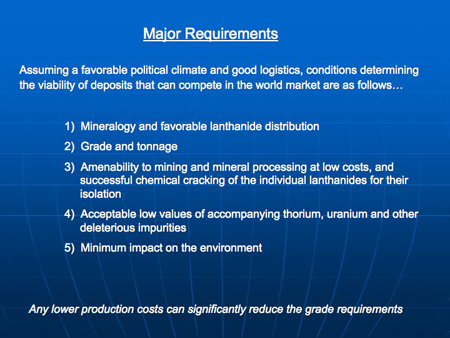By Clint Cox
On February 26th, the rare earth community gathered for an entire morning of REE talks during a special session at the annual SME conference in beautiful Salt Lake City (the Great Salt Lake pictured below).

The session was titled “Rare Earths – Mining, Geology, and Metals” and was chaired by James Hedrick of the US Geological Survey. It was well attended. The schedule is listed below (my comments follow each):
Magnetic Refrigeration/Heat Engines
K. Gschneidner and V. Pecharsky; Ames Laboratory and Department of
Materials Science and Engineering, Iowa State University, Ames, IA
Karl Gschneidner gave excellent insight as to what the future may hold in magnetic refrigeration. Gadolinium is the chief rare earth element used in the technology, but he also made it clear that there are lots of materials being researched for this application. On 20 February 1997, magnetic refrigeration was proven to be viable, but we may still be years away from mainstream magnetic refrigeration. At this point 29 machines have been built (that we know of).
Significance of REE-, BA-, and F-RICH Primitive, Ultrapotassic Dikes
in the Southern Mountain Pass District, Mojave Desert, California
G. Haxel; U.S. Geological Survey, Flagstaff, AZ
Gordon Haxel gave a fascinating — and highly technical — presentation on the shonkinites at Mountain Pass. He gave great insight about the different rock types and essential elements of the Mountain Pass geological structures.
Criteria for the Evaluation of REE Deposits on a World Level
A. Mariano1, J. Hedrick2 and C. Cox3; 1Consultant, Carlisle, MA; 2Minerals
Information Team, U.S. Geological Survey, Reston, VA and 3The Anchor
House, Inc.
Anthony N. Mariano spoke about evaluating REE deposits around the world. The key slide he presented discussed the criteria for evaluating REE deposits:

Dr. Mariano went on to give specific examples of critical REE minerals and their deposits.
Thorium and rare earths in the Lemhi Pass region
R. Reed1 and V. Gillerman2; 1Idaho Engineering & Geology, Inc., Boise, ID and Idaho Geological Survey, Boise, ID
Reed and Gillerman provided a fresh look at the Lemhi Pass region of Idaho using new and updated data. They have established that the project has a large amount of thorium and 0.52% REO.
Ion-Absorption Type Lanthanide Deposits
R. Grauch1 and A. Mariano2; 1Mineral Resources Team, US Geological Survey, Denver, CO and 2consultant, Carlisle, MA
Grauch gave the best presentation I have ever heard on the South China ion-absorption clays. He stressed the importance of the clays to the REE industry. He showed a detailed map of the five provinces that have the deposits and explained that there were more than 100 such sites known in China.
Rare Earths Supply: the Alternatives to China
D. Kingsnorth; Industrial Minerals Company of Australia, Perth, WA, Australia
Kingsnorth furnished great statistics for the standing-room only crowd. He predicted a 9-11% growth rate for the industry, and displayed charts showing that China may absorb the entirety of its own production by 2012. He discussed the shortage of dysprosium (Dy), neodymium (Nd), europium (Eu), and terbium (Tb). He also explained that provinces that produce rare earth want to encourage the growth of local manufacturing by having companies come in and build plants there rather than exporting the rare earths.
Geology, Setting and Development of the Hoidas Lake Rare Earth Element Deposit
G. Billingsley, J. Pearson and K. Halpin; Great Western Minerals Group Ltd., Saskatoon, SK, Canada
Billingsley gave an update on progress at the Hoidas Lake project. He detailed some of the new developments in sorting and processing the ore, and updated the value of the oxides at Hoidas. During my trip to Salt Lake I was able to go with Great Western to their new Deep Sands project — I will have more on that soon.
Rare-Earth Operations at Chevron’s Mountain Pass Mine, California
J. Benfield; Chevron Mining Inc., Mountain Pass, CA
Benfield gave a thorough update on recent plans for Mountain Pass. Chevron Mining has been training new managers and is gearing up for a three phase start-up. They hope to be in full operation by 2012. They are also actively researching new technologies to use rare earths.
It was a wide-ranging conference covering distinctly different aspects of the REE industry. The crowd was a good mix of REE legends, new-comers, geologists, engineers, and financiers. I certainly hope that they decide to do this again next year, as it was an excellent forum to learn many aspects of the business and get to mingle with some very knowledgeable people.

